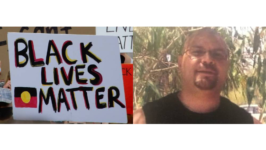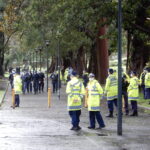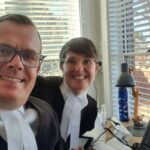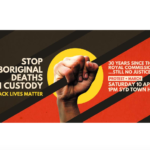Justice for Mr Riley: An Interview With Cassandra Riley and Dr Hannah McGlade

The coronial inquest into the death in custody of Mr Riley came to a close on 1 June. The 39-year-old Noongar man was tasered a total of 10 times in the carpark of East Perth Officeworks on the morning of 12 May 2017.
The father-of-six became unresponsive as he was being held down for possibly up to 10 minutes in the potentially lethal prone position by multiple police officers. And soon afterwards, he was pronounced dead at the scene.
While video footage capturing the incident was played in court, the coroner has refused to release it, despite the family requesting it be available to the public.
WA police officers weren’t looking for Mr Riley. They came across him in a distressed state in the carpark, as they’d been inquiring into allegations that two women had been shoplifting.
At first Mr Riley didn’t respond as officers attempted to speak with him, and according to WA police, he became aggressive when they pressed the issue.
The footage captured by an eyewitness is reported to show multiple officers pile on top of Mr Riley, after he’d already been tasered multiple times. And despite what police claim in regard to his resisting arrest, those who’ve viewed the footage state they saw a man face down crying out in pain.

The case for taser reform
Tasers deliver an electric shock to a person, causing them to seize up. These weapons are seen as a nonlethal means for police officers to render a suspect powerless. However, questions are increasingly being raised as to the “harmless” classification that’s applied to these weapons.
National Aboriginal and Torres Strait Islander Legal Service (NATSILS) executive director Dr Hannah McGlade last week called for tasers to be banned. She added that if police officers do repeatedly discharge a taser to the point that someone dies, they should be held accountable.
Two WA police senior constables were found guilty of assault, after they tasered Kevin Spratt a total of 13 times in August 2008. The officers attacked the Noongar man with their weapons, following his refusal to be strip searched at East Perth watch house.
While Gamilaroi man Michael Peachey died in Gunnedah Hospital on 24 May this year, after NSW police officers attended his home, where they tasered and pepper sprayed the 27-year-old father.
According to Professor Thalia Anthony, his death is not being classified as a death in custody, although it is the ninth First Nations custodial death to have taken place nationally since the beginning of March.
Coronial misgivings
On the evening prior to the incident, Mr Riley was pulled over by police as he was reported to be driving erratically. He was taken to the watch house to run tests and was subsequently released. The attending officers said they then took him to the hospital at his own request.
Mr Riley waited for around eight hours to see a doctor, but to no avail.
Cassandra, Mr Riley’s sister, was present throughout the six day inquest into her brother’s death. She was accompanied by Dr McGlade. And both of them stress that the police version of events doesn’t add up.
Sydney Criminal Lawyers spoke to Cassandra Riley and Dr McGlade about the inconsistencies between the accounts reported in the press and what they viewed on the footage, the issue with the use of tasers, and what justice served would look like for the Riley family.
Firstly, the six day coronial inquest into Mr Riley’s death in custody finished yesterday. How would you describe what transpired? Has the coroner given any indication as to what the outcome could be?
Cassandra: The decision is not complete. The coroner did say it looks like the police acted reasonably. But he is going to look further into the evidence. He said it’s going to take him a couple of months before he comes to a decision.
So, now it’s just waiting on his decision to see if the police will be held accountable for their actions.
Dr McGlade: Although, it doesn’t seem that they’re going to be held responsible, because they had such a good story to tell the court.
The eight minutes of footage capturing the encounter in the carpark with police was shown during proceedings. The court has refused to release it to the public. What did the footage reveal?
Cassandra: The footage says it all. You can clearly see how they all were on top of him. Their restraint was excessive.
Every officer said they were exhausted. But if they were exhausted by using all this force and putting their body weight and strength down upon my brother, how do you think he felt?
There would have been at least 13 officers on top of him. Then one indicated that his breathing had stopped, and his face was turning purple.
Was it the case that a few officers approached him at first and then more turned up?
Cassandra: A witness in Officeworks approached two officers on their way out from another inquiry. They were told there was a man in distress, who looked like he needed some medical assistance, and they were asked to call an ambulance.
The officers approached him. They saw him in a slumped position. He was really unwell. He was groaning and moaning with his head bent down to his knees. They began speaking to him, but they did not get a response.
So, one of the officers then tapped him on the forehead and grabbed him by the foot and started shaking it, trying to get a reaction. I’m not sure how long that was going on for, but, to me, that’s agitating or aggravating someone.
In the state he was in, he jumped up. The police reaction was that it was a threat to them, because they got that reaction out of him. And unfortunately, that’s when the taser was deployed.
Dr McGlade: They claimed in court that he jumped up and threatened to kill them. But he wasn’t able to talk when he’d previously been at the hospital and at the Perth watch house the night before.
An officer at the watchhouse described him as being calm, compliant and not able to speak. But then the officers said he threatened to kill them and that was their excuse for tasering him.
So, on the night prior, Mr Riley had been taken to the watchhouse over driving erratically, and he’d then spent eight hours in a hospital emergency room waiting for assistance as he was concerned about his mental state.
Cassandra: The police did pick him up in his car the night before and were concerned about his health. They handcuffed him and took him back to the watchhouse, although he wasn’t arrested.
They took some blood samples. They then took him across to the Royal Perth Hospital. The footage shows that on entry he was carrying his blood sample in his hand.
Mr Riley went into the triage with the nurses, but he couldn’t speak. The police didn’t explain to them what was actually happening. He still had his blood sample in his hand.
The nurses couldn’t help him. They couldn’t get any words from him. And then he was accompanied by police as he walked out.
He was in the waiting room, and then he kept going back in and out for an eight hour period with his blood sample in his hand.
If there had been proper communication about what he was doing there with his samples, and they then knew how to medically assess him, my brother might still be alive today.
The officers returned to give Mr Riley a note that explained where his car was parked. So, he had his car keys, his glasses, his blood sample and a note telling him where his car was parked.
That says it all: they knew he wasn’t in his right state of mind because he needed a note to find his car.
The whole time on the hospital footage, he was really calm. He was just waiting around to see a doctor.
If my brother had been in his normal state, he would have been talking to others and asking for help.
So, back to the incident, are you saying that the initial officers tasered him and the others came along afterwards?
Cassandra: He was still being tasered while he was on the ground. You can hear the taser continue to go off. The noises that you can hear coming from my brother are so distressing. He is moaning.
Dr McGlade: They called the ambulance. And then they called the extra police. There were so many cars. And at the inquest, it was two days of police officers giving evidence.
The other thing was the officers didn’t have body cameras. It might not have been a requirement. We see him in great distress being horrifically restrained. As for the claim he attacked the officers, it’s really all their word that he acted in this way.
They also claimed that he went for their gun – the only print they got was a slight print on the gun. There were no prints on the belt holster that holds everything in place. And they were all on top of him. There were many police at the court, they were clearly all there to hold this position.
Cassandra: They were tasering him while he was on the ground. There were five of them all around his legs, and they were using their batons to help hold his legs down. One officer mentioned that his shin was hurting as it pressed against my brother’s shin.
How do they think my brother was feeling? All that pressure. He was being suffocated. The report said there was blood in his lungs, which indicates there were blood clots forming in his legs and clogging up his arteries.
There was no oxygen getting to his heart. He was being tasered at the same time, so all of his stress levels would have been intensified.
They said at the time his ear was turning purple. They had him face down in the prone position, with his hands cuffed above his head. They called it the superman position.
Dr McGlade: They were saying in the court that he was violently resisting, but if you look at the footage, he looks like a man who is being killed. He’s shaking his legs and crying out in pain.
What light did the inquest shed on the use of tasers?
Cassandra: Five experts came in to have a discussion about the use of tasers. One mentioned that there was contribution from the taser usage that caused heart failure.
Another two claimed that tasers are not lethal, as they stimulate the nerves and cause pain. US expert Dr Ho said, tasers have been tested on people who have been pepper sprayed at the same time, and he seemed to think they were okay.
But they’ve got a limit when they’re testing the tasers that they don’t exceed. Therefore, how can they determine that being tasered excessively is not going to result in death.
Dr McGlade: The other thing was last Friday, there was a cardiologist who said in psychiatric wards – in places where they use restraint on patients – there is a rule that three minutes is the longest time that you would hold someone in this prone position, and then you put them on their side.
The doctors are aware that you can kill a person like that. There needs to be a rule around police using this position. They shouldn’t be allowed to hold them in a position that can kill people.
Cassandra: The police said they are aware of the dangers. They said they’d been trained in the signs and symptoms of positional asphyxia. Yet, they might have known the signs, but they didn’t do anything about it.
Dr McGlade: When they were holding him down, you can hear the sounds of the taser. But you cannot hear the police talking to him at all, like he was a human being. They were all just piling on top of him.
We have a real racial profiling problem in WA. Police are constantly arresting Aboriginal people and there is evidence that Aboriginal motorists are being pulled up at a higher rate, than non-Indigenous motorists.
Mr Riley’s death could have been avoided if they had just treated him as a human being in need.
Cassandra, you’re now waiting on the coroner’s findings. So, what would a just outcome look like for your family?
Cassandra: We want accountability, both with the police and the hospital staff. We have a list of recommendations that we would like to be put in place.
I’ve suggested that there should be 24 hour mental health workers and Aboriginal liaison officers at the hospital to assist Aboriginal and Torres Strait Islander people.
There are mental health workers that do work with the police, but they only work from 1 pm to 1 am. So, there’s a question around what people are going to do for help outside those times.
There are velcro restraints that can be wrapped around a person’s legs. Police have them. They can be wrapped around a person’s legs, so there is no body weight being used upon them. These should be in police vehicles at all times so they can be used.
Police should be aware of the dangers of the prone position, and it should not be used. And when they are approaching people, they shouldn’t agitate them, especially if they are having mental health issues.
Police should undergo regular mental health awareness programs and cultural awareness programs. Not just the one-off when they’re in training, but it should be recurring.
We also want tasers banned, or else, leave them to the last resort.
Dr McGlade: The one thing that struck me was the coronial process was flawed from the start, because it involved police investigating police conduct.
That’s against the recommendations of the Royal Commission, and it’s also the standard required under UN international human rights law.
Cassandra: The coroner took on the suggestion of 24 hour mental health workers at the hospital, but he then questioned who would work those hours.
Dr McGlade: The whole court was racist. The family was treated poorly.
The Victorian Coroner has set up a Koori Engagement Unit. But, in Western Australia, where we have more deaths in custody than anywhere else, we don’t even have an Aboriginal staff member at the court.
It all seemed very disrespectful to the family, including the way police were acting in the court.







